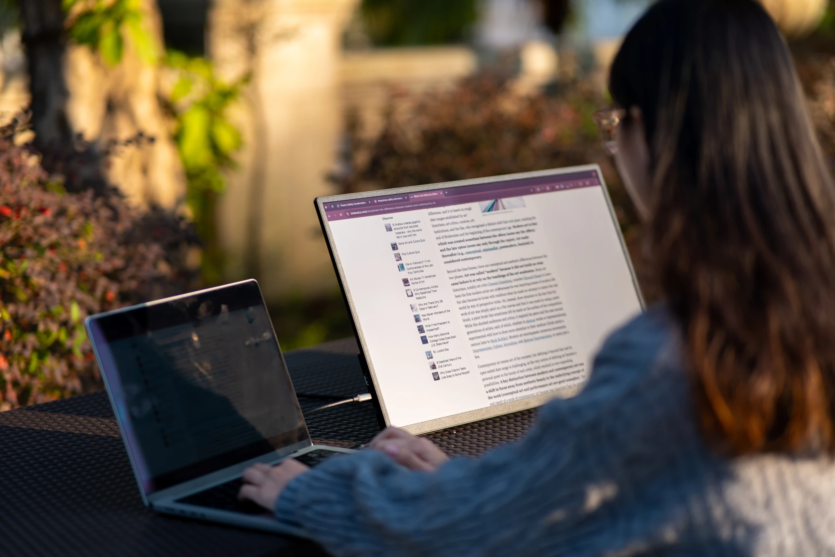Think of displays, and chances are that devices such as smartphones, laptops, TVs, and monitors come to mind before anything else. They have one thing in common: all of them are powered by backlit LCDs or OLEDs that shine light directly into your eyes. A new category, known as Reflective LCD (RLCD), is available and serves as the middle ground between power-hungry backlit LCD panels on one hand and slow-refresh e-ink screens on the other. One of the most notable examples is the Eazeye Monitor 2.0, a 24-inch RLCD monitor that’s trying to carve out its niche of its own.
So what exactly makes RLCD different—and why should you care? Let’s take a closer look.
How RLCD Works
One thing that needs to be stated right at the onset is that RLCD is basically LCD technology at the core, but with some slight modifications. So, it isn’t anything revolutionary, so to speak, but some ingenious development over traditional LCD that makes it a lot more eye-friendly. Unlike standard LCD panels that come with an internal backlight to push brightness through their liquid crystal layers, RLCD skips on the backlight thing altogether. Instead, it relies entirely on ambient light to illuminate the display so that it becomes visible to our eyes.
That way, RLCD can well resemble print on paper. Just as a printed page can be read even under direct sunlight without the need for it to glow on its own, the same goes for RLCD panels that show images simply by reflecting available light. This eliminates glare from direct illumination and drastically reduces the eye fatigue commonly associated with staring at a glowing panel for long hours.
From a technical point of view, RLCDs achieve this thanks to a reflective layer that is added behind the liquid crystal matrix. Rather than transmitting light or requiring a translucent back panel, this reflective backing bounces ambient light back at the viewer, carrying the filtered color and shape information along with it.
Specs That Stand Out
Meanwhile, here is the spec list of the Eazeye Monitor 2.0 featuring a modern RLCD panel:
- Resolution: Full HD (1920 × 1080)
- Refresh Rate: 60 Hz (this makes for a considerable jump over E Ink’s sluggish response)
- Response Time: ~15 ms
- Colors: Up to 16.7 million shades
- Contrast Ratio: Around 1000:1
And here’s the kicker: the monitor, as the website ITC.UA reported, sips just 4–7 watts of power, compared to 30–40 watts for a standard 24-inch LED-backlit monitor. That makes it one of the most energy-efficient full-color desktop displays around.
RLCD vs. E-ink vs. LCD
- Compared to e-ink: RLCD offers smooth scrolling and video playback thanks to its standard 60 Hz screen refresh rate. This is something that E Ink still struggles to achieve owing to slow refresh cycles, thereby leading to ghosting effects. However, E Ink typically offers higher reflectivity and sharpness in text-heavy use.
- Compared to LED-backlit LCDs: RLCD consumes a fraction of the power compared to traditional LCD, while blue-light emission is also reduced to just the bare minimum. However, it requires strong ambient light to look its best. In a dimly lit room, you may need a desk lamp to see clearly, much like reading a book.
This hybrid positioning makes RLCD a fascinating compromise: more dynamic than e-ink, yet gentler on the eyes and greener than conventional LCDs.
Who Is It For?
RLCD isn’t designed to replace every screen. If you’re a gamer or a video editor, color accuracy and brightness might feel lacking. But for writers, coders, researchers, or anyone who spends long hours reading or working under natural light, RLCD could be a game-changer.
Outdoor professionals—architects, engineers, or field researchers—may also find RLCD useful where sunlight makes backlit screens nearly unreadable.
The Road Ahead
Reflective displays aren’t new; attempts like Pixel Qi tried and failed to gain mass adoption over a decade ago. But today’s rising demand for eye-friendly screens and low-power electronics may give RLCDs a second chance.
Whether the Eazeye Monitor 2.0 sparks a wave of adoption or remains a niche experiment, it proves one thing: the way we build and interact with screens isn’t finished evolving. RLCD offers a glimpse of what displays might look like in a future where efficiency and comfort matter just as much as brightness and resolution.


